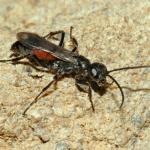A medium-sized, black and red species. It belongs to the subgenus Priocnemis sens. str., which includes, amongst the females, some of the most difficult of the British species to identify. Typical specimens have transverse striation on the propodeum well developed, relatively short, thick antennae, and a narrow metapostnotum. Males have distinct genital plates, but must be prepared properly to appreciate this character.
Widespread in southern and central England, also occurring in the south-west and Wales where it is mainly coastal and just reaching southern Scotland. Absent from Ireland (O’Connor et al., 2009).
Overseas it occurs in much of Europe, although absent from Norway and Sweden and parts of the western Balkans (Wahis, 2011). Also in North Africa, and northern Asia (Wolf, 1972).
This species is not regarded as being scarce or threatened.
A species of open habitats on light soils; heathland, acid grassland, chalk downland and coastal sites.
It flies from May to September, with a peak in August.
Prey consists of spiders in the families Salticidae and Clubionidae.
Relatively poorly known, partly through confusion between similar species. Gros (1982) records the species, in France, using an abandoned burrow in which its own cell was excavated.
Like most Priocnemis species it is fond of umbellifer flowers, and has been recorded from wild parsnip and wild carrot used as a lure (Baldock, 2010; pers. obs.).
2016


